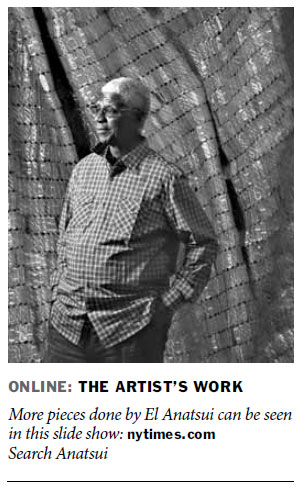Artist unveils Africa in tiny parts
Updated: 2013-02-17 08:39
By Holland Carter(The New York Times)
|
|||||||
|
The Ghanian artist El Anatsui, below, with "Red Block" (2010), has become a global star by keeping Africa in his heart and his work. "Earth's Skin" (2007). Photographs by Chester Higgins Jr. / The New York Times |

One of the Venice Biennale's most popular sights six years ago was an immense sheet of undulant light floating, floor to ceiling, in the main hall. In a city of mosaics, it could have been a super-mosaic, inlaid in silver and gold. You saw that the whole glinting thing was pieced together from countless tiny parts: pieces of colored metal twisted into strips, squares and circles, linked together with bits of copper wire.
You could make out words printed on some of the scraps: Bakassi, Chelsea, Dark Sailor, Ebeano, King Solomon.
Some of them sounded foreign. So, when you learned it, did the artist's name: El Anatsui.
In that great sheet of light, you saw Africa, not Europe; kente cloth, not Baroque tapestry. That the metal pieces looked like scrap material became significant. Cliches clicked into place: Africa = recycling. And art that, a moment before, was simply blow-away gorgeous was now exotically mysterious.
How did art by an African artist become the centerpiece of the world's most prestigious contemporary showcase? Historically black artists from Africa had achieved international attention only when they lived and worked outside the continent. And then their art was embraced to the extent that it advertised African-ness. Mr. Anatsui's Venetian tour de force fit neither criterion.
Now, six years later, those "how did this happen?" questions may again arise around the sparkling retrospective exhibition "Gravity and Grace: Monumental Works by El Anatsui," which runs until August 4 at the Brooklyn Museum in New York.
Mr. Anatsui was born in 1944 in Ghana, which was then a British colony, the Gold Coast. His father was a fisherman and master weaver of kente cloth, a skill Mr. Anatsui himself never learned.
Instead he studied art in high school and university programs conceived on British models. At the same time he made an effort to immerse himself in local Ghanaian traditions. "When I left art school, my idea was to try to indigenize - to get a bit of indigenous material into my psyche," he once told an interviewer. And his first work as a professional artist, in the early 1970s, was local in a literal way.
It was a series of wall pieces made from wooden display trays collected in town markets. On the surface of each tray, he scorched symbols from Ghanaian textiles, symbols of myth and memory. Seen in a Western context the results looked abstract; in Africa they had specific meaning.
The series also established features that would characterize much of his future output: a reliance on mediums close at hand, portability and abstraction.
In 1975 Mr. Anatsui was invited to teach sculpture at the University of Nigeria in the town of Nsukka. It became his new and, so far, permanent home.
Soon after arrival he started making ceramic sculptures in the form of shattered and patched-together versions of traditional pots, their interiors filled with seething, snakelike forms. These were fierce, agitated, disintegrative objects, responses to his own mood of displacement, or to a post-colonial Africa entering dire, disillusioning times.
The sense of turbulence continued when he returned to wood as a medium. In 1980, he adopted power tools to make sculpture.
By 1990, when the Studio Museum in Harlem sent curators to Nigeria to scout for its "Contemporary African Artists: Changing Tradition," Mr. Anatsui was high on the list. And when five artists from that exhibition were chosen for the 1990 Venice Biennale, he was one. The occasion was historic; it was the first time sub-Saharan artists had been in the Venice show.
In 1995 a London dealer, who came across a video of him sculpturing with a chain saw, offered a show that coincided with the city's breakthrough Africa '95 Festival. In the same year a solo show in Japan came through. And in 1996 in New York the dealer Skoto Aghahowa paired Mr. Anatsui in a show with the American artist Sol LeWitt.
A tipping point arrived in 1998, when Mr. Anatsui invented a new art form. One day, by his own account, on a routine scavenging hunt through Nsukka, he picked up a trash bag filled with twist-off liquor bottle tops of a kind manufactured by Nigerian distilleries. He had found his ideal material: locally made, in ready supply and culturally loaded.
Liquor had come to Africa with colonialism. Production of rum propelled the trans-Atlantic slave trade. Later Africa had made a double-edged European import its own. And the history of all that was printed, in shorthand, in the brand names on the bottle tops: Bakassi, Chelsea, Dark Sailor, Ebeano.
"When I started working with the bottle caps," he said recently during a trip to the United States, "I thought I'd make one or two things with them, but the possibilities began to seem endless."
Like the earlier ceramic and wood-panel sculptures they speak in universal terms of decay and regeneration.
Outdoors is the direction Mr. Anatsui wants to go in the future; he will be doing an installation on the exterior of the Royal Academy in London in the spring and another in Amsterdam. Large but light and lighter is the goal. Mr. Anatsui said: "I'm working toward buoyancy."
The New York Times
(China Daily 02/17/2013 page12)
